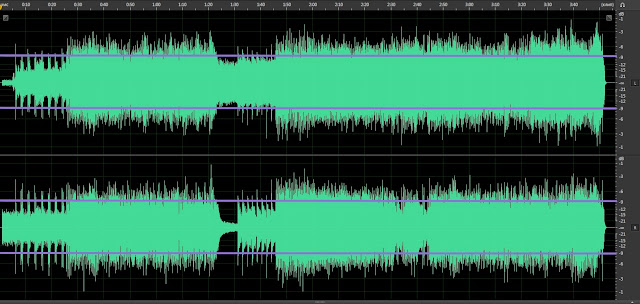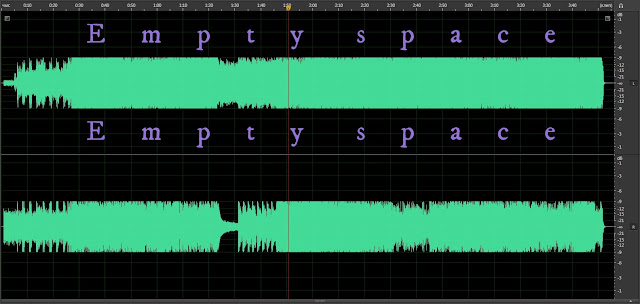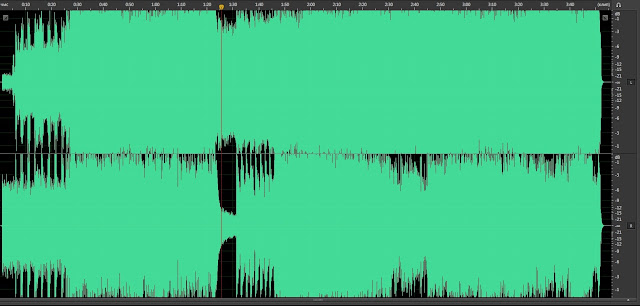How to Listen to Music Properly (Is Hi-Fi Audio Worth It?)
This article explains what high quality sound is, why it’s crucial for people
who say music is an important part of their life, and how to ensure you get
the best sound quality (and the most pleasure) out of the music you listen to
at home.
You will learn:
- how to choose between specific editions of the same album and pick the one that sounds best
- about dynamic range, bit rate, frequency rate, and bit depth
- which of these parameters you should and shouldn’t care about
And my next article will discuss how to choose components for a Hi-Fi stereo system on a modest budget for enjoying your favourite music at home.
Now, let’s get
down to business.
What You May Be Missing Out On
“How to listen to music?” What does this question even mean? Obviously, you
just put on your headphones plugged into your phone or computer, turn the
music on, and listen to it while, at the same time, doing whatever else you
are doing.
No. There is a much better way. If music is an important part of your life and
one of the biggest pleasures, I’m going to share the basics you
must know to enjoy music to the fullest while also staying on a
reasonable budget.
Most people are content with listening to music via the ways popular because
of their compact convenience: streaming services, YouTube, or MP3 files run on
their phones, computers or multimedia devices.
I’m not saying you
can’t get tremendous enjoyment from music this way. But music can give you
even more pleasure and help you discover indescribable sensations you haven’t
experienced before if you:
- learn what the high quality sound is (including what it isn’t and what marketing gimmicks you shouldn’t care about)
- get at least a simple and budget-friendly Hi-Fi stereo system and set it up properly
- start listening to high quality music on this system with full concentration
We will discuss the first aspect further in this article. And the second one — in my other blog post. As for the third step, let me explain myself right now.
Most often, people listen to music on the go, using it as a background for
doing something else at the same time. But to get the full range of emotions
out of your favourite music piece, try to dedicate time to listening to it
without doing anything else. Just sit down, relax your body, close your eyes,
and concentrate on every detail you are hearing.
This is what I do
on weekends in front of my Hi-Fi stereo system. It’s kind of a ritual helping
me have a rest from a long, tiresome, and annoying working week. Some of the
best moments of my life were spent in front of my simple stereo with my eyes
closed, keeping myself in a state of euphoria for the duration of an album.
When played by a Hi-Fi stereo system, music sounds more beautiful and exciting: clearer, more natural, more realistic. A drum fill or another musical phrase often causes a "wow" effect not only because it's composed and played masterfully but also because it sounds very alive, like if the musician was playing live just in front of me. This doesn't happen when I listen to music on lower quality equipment, especially while being busy with something else at the same time.
I had never known a pleasure like this before I bought my stereo, even though
I’ve been an avid music lover since my childhood. A high quality (though not
at all luxurious) piece of equipment was one of the two missing puzzle pieces
for me to find the maximum pleasure my passion for music could give me.
Normally,
you get used to good things and stop viewing them as something special after
some time. For me, my stereo is an exception from this rule. Even after ten
years since I purchased it, every weekend I’m excited about my upcoming
listening. I’ve never been a fan of automobiles, and it sometimes looks silly
to me when a man treats a piece of equipment — their car or motorcycle — as if
it was their friend or family member. But I feel a similar thing when I look
at my stereo that “produces the finest of sound” comforting me, curing
me from the bad emotions caused by the troubles and frustrations of my
everyday life.
The second piece of the puzzle was learning what Hi-Fi sound is and how to choose the right Hi-Fi music (versions/editions of an album) to listen to. So before talking about equipment (in my second article), let’s talk about the sound first.
What Is Hi-Fi Sound Quality?
The definition of Hi-Fi is “high fidelity”. The meaning of Hi-Fi as a term is
to describe audio equipment (or recording) capable of reproducing sound in the
closest possible way to how it sounded in real life at the moment of being
recorded.
Let’s go over the most important characteristics that
define the quality of a sound recording.
Dynamic Range (and Loudness War and How to Choose Recordings with Good Sound)
Definitions and Meaning
Dynamics in music means the
difference between loud and quiet sounds. The dynamic range is a
measure that defines how large of this difference a sound recording or
equipment can produce. The higher the range is — the more natural the
recording sounds.
Dynamic compression means reducing the dynamic range to make the
difference between the loud and quiet sounds smaller. Note that this
compression has nothing to do with bit rate such as the MP3 compression. We’ll
talk about that type of compression in the next section.
Dynamic compression is a necessary tool in some cases, when used reasonably.
It helps reduce overly loud sounds. For example, this is necessary for
recording vinyl discs, as the maximum dynamic range of a vinyl is about twice
lower than the one of a CD (55-65 dB vs 96 dB respectively).
The
term loudness war refers to the tendency of music producers to apply
dynamic compression to recordings to an extent that they start sounding bad.
This is done to make the overall volume of the recording higher.
Let
me illustrate how dynamic compression works. Here is a good, natural recording
(the song Prowler from Iron Maiden’s eponymous 1980 debut album):
To dynamically compress a song and make it louder, first, you cut the peaks (reduce the volume of the loudest sounds) similarly to trimming grass with a lawn mower:
Now we have enough free space to fill by amplifying (normalising) what remains from our poor mutilated recording:
Now our recording sounds loud, modern, trendy, and awful. Read on to learn why it’s done in the music industry.
A Bit of History
Sometime around 1996, sound producers noticed that albums that sounded louder sold better than the ones that sounded quieter. This is due to the fact that at a first glance, for an inattentive listener, a music piece that sounds louder is perceived as sounding better than a quieter one. So in a radio broadcast and on a CD, every label wanted to sound louder than their competitors (the same goes for TV commercials).
This led to sound producers abusing dynamic compression for the sake of loudness and higher sales, as for most consumers, who don’t pay attention to sound quality, “louder” is more noticeable than “more natural”.
Ever since, this tendency has been growing. Albums released in 1996 sounded worse than the ones released in 1995. Albums from the 2000’s sound even worse than in 1996. Albums from 2010, 2023, and so on, are even worse than that…
Nowadays, even independent musicians (even those who claim they are “underground”) compress their music to make it louder. Perhaps, they want it to sound “professional”, taking major labels’ releases as an example.
I’ve heard from one musician that doing this is an “artistic choice”. No, it’s not. There is nothing artistic about it. Compressing a song just to make it louder means making the sound literally worse — less natural and less detailed. There is no excuse for this.
Modern equipment allows possibilities sound engineers of the past could only dream of. Yet most modern albums sound worse than the ones recorded in the 60’s and released on CD in the early 80’s.
That’s how modern producers continue killing the wonderful potential of modern technological advancements because of the need to correspond to the modern sound “trend” started in the 90’s, originating from the major record labels’ greed taking over the artistic value that music recordings could offer, and intoxicating even alternative and underground music genres.
There are rare exceptions though. Some modern albums (and modern reissues of old albums) aren’t overly compressed.
How to Choose a Good Sounding Version of Your Favourite CD Album (and Avoid Bad Ones)
No matter how high quality, luxurious, and state-of-the-art your Hi-Fi system is, if the album you are listening to is overcompressed dynamically, you won’t get good sound out of it. However, it may sound okay in headphones: the flaws of dynamic compression aren’t as noticeable in headphones as while using speakers.
A dynamically compressed song sounds less clear and less natural. There is a feeling that something is missing. You may not notice this at once. It requires some experience.
Dynamic compression especially degrades the quality of dense music (such as rock, metal, and electronic music with heavy synthesisers) more than recordings of lighter genres (pop, jazz etc).
I have editions of jazz and jazz-funk albums released in the late 2000-s, and they sound good enough, even though somewhat compressed. However, I’ve also come across a jazz-funk album compressed to an extent of sounding terrible, too — Godchild (1975) released on the label of the rapper Kid Loco in 2002.
Excessive compression is also applied to modern vinyls. So switching to vinyl won’t save you from the need to choose between editions.
The dynamic compression tendency has been going on since about 1996. Almost any modern album is overly compressed. Some albums released in 1996-1999, though compressed, still don’t sound too bad. But generally, the more recent an album is, the worse it sounds.
This is also true for reissues (“remasters”) of old, pre-loudness war albums that were originally released in the early 80’s-early 90’s on CD. This is one of the reasons why it’s important to choose a specific edition of an album you want to buy (or download and write onto a CD-R).
The other reason is that in the old days, different editions sounded differently: for example, Japanese editions were often (but not always) richer in high frequencies than European and American ones, etc. For some economical reasons, for labels in different countries it was more economically viable to have their local sound engineer mix and master an album from separate tracks than licensing an already mastered mix from the original label.
Another difference was in the presence of bonus tracks (often in Japanese editions), different packaging, and other details.
Editions of modern music albums (after the mid-90’s) seem to have the same sound in most cases, no matter the country and label licensing the album. But the later a “remaster” was released, most often, the louder (and worse) it sounds.
As my preferred media type for Hi-Fi listening, I chose the CD. It’s cheaper than vinyl (and sounds better to me), and I can just download CD rips online, choose between rips of specific editions of an album, and write the one I like most onto a CD-R. I haven’t tried streaming platforms (except for the free version of YouTube), but I suppose that the crucial option to choose between specific editions of the same album is absent there.
Another flaw of online streaming is the dynamic compression added by streaming platforms on top of a song’s own compression. To prevent songs on their service from varying in volume, they compress them dynamically (like radio stations do). For these reasons, I don’t consider streaming services a valid Hi-Fi music source. Perhaps, there are specialised streaming services with good sound for audiophiles, but I don’t know of any.
So before buying an old album on CD, it’s better to download CD rips of its various editions (Japanese, European, American etc) in FLAC or another lossless format (or even MP3 — for a quick assessment), compare their sound, and choose the one you like the best. And only then spend your money on a physical copy (if you need to buy one at all. Otherwise just record a CD-R from FLAC).
Give preference to releases before 1996 — that’s when the loudness war began, as per my observation and analysis of about two hundreds of albums.
If you don’t know where to download CD rips of various editions of almost any album for free, ask me for advice. My contacts are here.
Some modern albums aren’t overly compressed. It’s very rare, but it happens. For example, both the debut EP — Ruines Humaines (2006) and the subsequent eponymous album (2009) by Amesoeurs (a French black metal/shoegaze/post-punk band) have a very good dynamic range. The only flaw on the album is the overly loud kick drum, which I fix by slightly reducing the bass by turning the knob on my amplifier when listening to the album on my stereo. And in headphones it sounds fine.
Finally, here is a list of all albums I have (the ones worth listening on a stereo through speakers), including information on specific editions that I chose for myself. I didn’t specify other editions that I have tried and that had the same sound as the ones I selected — I only wrote down the ones I kept for myself. And some other editions may sound better to you personally. So if you can, find and download various options and compare them yourself.
Bit Rate (Difference Between MP3 and WAV/CD)
You probably know what the difference is between MP3 and WAV (or audio CD) quality: MP3 is compressed, and the higher the compression is the worse it sounds.
But how exactly is it compressed? What is thrown away? Let’s see.
Sound waves we hear are fluctuations of the air. The number of these fluctuations per second (frequency) is measured in Hertz (Hz). One fluctuation per second is one Hertz.
Generally speaking, a human ear can hear sound in the range from 20 Hz to 20 000 Hz (or 20 kHz). But it’s generally speaking. If you are an adult, you likely can no longer hear frequencies above 16 kHz: as you get older, you lose the ability to hear the highest register.
An uncompressed audio recording contains much of the frequencies outside of human’s hearable range. So the meaning of MP3 compression is throwing away the frequencies humans can’t hear anyway. But the lower the bitrate is, the closer to the hearable range compression reaches, and at some point it crosses the line.
MP3 compression also throws away some of the sounds within the human hearable range: when two sounds occur at the same time, and one of them is significantly louder, the compression throws the quieter one away. This is because the human brain is built in a way that we won’t focus on the quieter sound anyway — we will only notice the louder one.
I tried hard to hear the difference between MP3 and Audio CD quality (WAV file). I couldn’t tell the difference between an MP3 of 192 kbps (and higher) and a WAV file no matter how I tried. I tested it on my Hi-Fi stereo system.
However, a 160 kbps MP3 file already sounded worse than the WAV one.
I’ve read opinions of people saying online that the difference is rather felt than heard. That MP3 makes you tired quicker than WAV. Perhaps it’s true and perhaps I’d need a more expensive stereo system or more sensitive ears or a longer testing session to hear the difference at higher bit rates than 160 kbps. But for me, this shows that the bit rate compression is a far less obvious factor than dynamic range.
You’ve probably heard about FLAC, ALAC, and other lossless compression formats. I haven’t researched how they work, but, obviously, they don’t sound any worse than WAV files to me.
To listen to music on my stereo, I download CD rips of albums in FLAC and write them onto CD-Rs. Even though I can’t hear an obvious difference between MP3 (192 kbps or higher) and Audio CD, I prefer not to risk missing out on a possible unobvious difference for the sake of saving space on blank CDs.
Hi-Fi vs Hi-Res (Bit Depth and Sample Rate)
Definitions and Meaning
The term Hi-Res (high resolution) refers to digital audio files (and equipment able to play them) with bit depth and sample rate higher than the ones of the Audio CD format.
The Audio CD format has a bit depth of 16 bit and 44.1 kHz sample rate. Audio CD is Hi-Fi but it’s not Hi-Res.
Audio recordings consist of small pieces — samples.
Bit depth determines how many bits of information a sample contains. The more bits a sample contains, the higher its resolution (and quality) is.
Sample rate is the speed with which these samples change each other.
Importance for Music Lovers
Fortunately, if you aren’t an advanced audiophile with super sensitive ears and a high budget for a hi-end stereo system, you shouldn’t care much about the sample rate and bit depth.
All standard CDs come in 16 bit/44.1 kHz format, which is enough for getting high quality sound. There are labels that release music in higher resolution, but those releases are rare and don’t make large catalogues of albums.
Modern computers are able to play Hi-Res audio. My computer is connected to a professional audio interface supporting Hi-Res audio, which is plugged into my Hi-Fi home stereo system. I tried to hear the difference between a recording with the standard 16 bit/44 kHz and the same recording with a higher resolution. I couldn’t feel it. Perhaps, I need a more expensive system or better ears to tell the difference. But still, this shows that it’s not a crucial factor.
Hi-Fi vs Lo-Fi Music and Equipment
The difference between Lo-Fi and Hi-Fi is that Lo-Fi is just an antonym to Hi-Fi. Any piece of equipment or recording that produces low quality sound is Lo-Fi.
Some music that I like is only available in Lo-Fi. For example, witch house: it's often badly mastered and overcompressed. It sounds terrible when played through speakers, so I only listen to it on my computer in headphones — like this, it sounds acceptable.
There are music pieces such as film scores that I extract from low quality video rips of old movies I like. The quality is bad, but the music is still enjoyable. Having no better option, I accept what is available.
Lo-Fi sound can also be a style or an artistic solution. Various artists use lo-fi samples in their songs to replicate the sound of archaic recordings from the 30’s-50’s... For example, the trip-hop band Portishead: their songs often feature tunes or drum beats sounding as if they were played on an old phonograph while the rest of the song’s sound quality is high.
Some people still listen to audio cassettes for nostalgic reasons — just to get the feel of the past decades when they were young and this type of media was common. I consider any cassette Lo-Fi because its 30 Hz to 16 kHz frequency range is narrower than what a human ear can hear and than what CDs or LPs can produce. Even though I, being an adult, no longer hear frequencies, above 15 kHz, cassettes just sound worse. I can tell that something is missing in comparison to a CD.
Cassette tape also produces a constant hissing noise. You don’t have to be an experienced listener to notice the flaws of the cassette sound as soon as you hear it.
In several decades, people will probably listen to music through a smartphone speaker, feel nostalgic about it, and turn it into a stylish retro trend as well.
Playback
Finally, another important factor for getting good sound is the equipment you play recordings on. The highest quality recording can’t sound good on a cheap multimedia device.
Manufacturers of regular multimedia sound systems use marketing gimmicks emphasizing the ability of a model to play extra powerful bass and high frequencies.
High quality sound, however, means balance and clarity. You don’t need bass to be “super”. You need it to be clear, not muddy, and as loud as it needs to be to sound good in combination with the rest of the frequencies.
The multimedia class equipment especially struggles with playing the mid range frequencies correctly. This is why the marketers emphasize the other two ranges, tricking you into believing that louder is better (just like they do with music albums, as discussed above).
In this article, I have answered the question “what is Hi-Fi music?”. And hopefully, it made it clear for you whether or not you should buy a H-Fi audio system.
The next blog post dives deeper into what a Hi-Fi audio system is and helps you decide what type of equipment fits your tastes and needs and how to get a good set on a tight budget. Read it here.
I created this blog for like-minded people with weird taste for unpopular, obscure, and sleazy films and music. If you feel our tastes are similar, let's be email friends. You can also reach out to me if you need help in finding any rare film or music mentioned in by blog.








Comments
Post a Comment